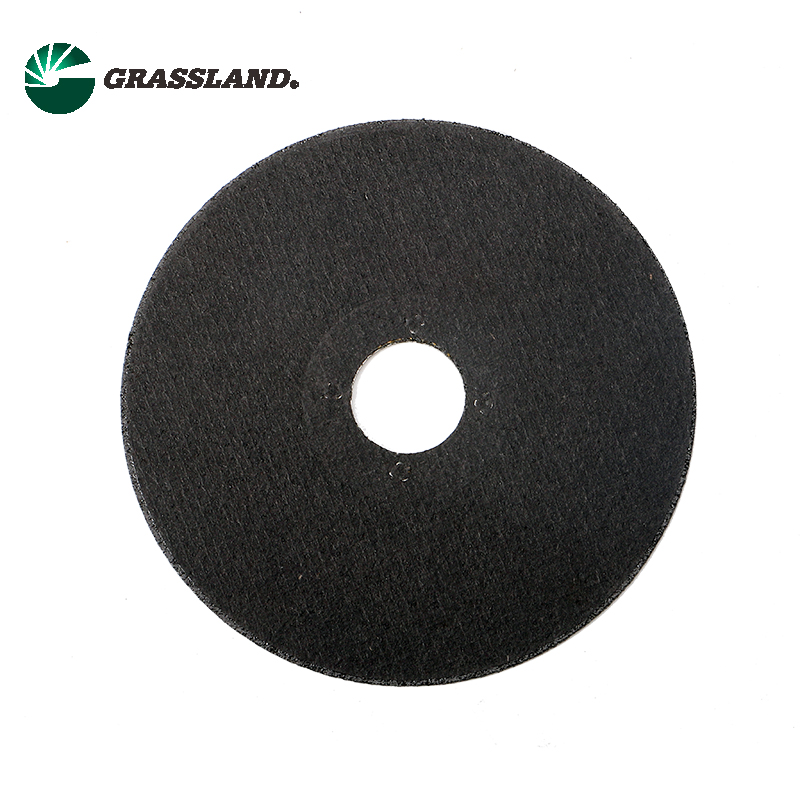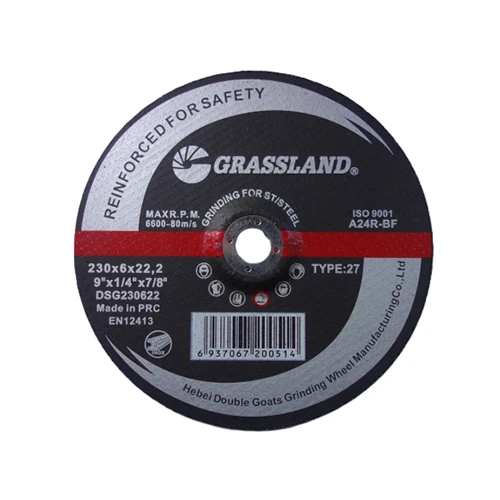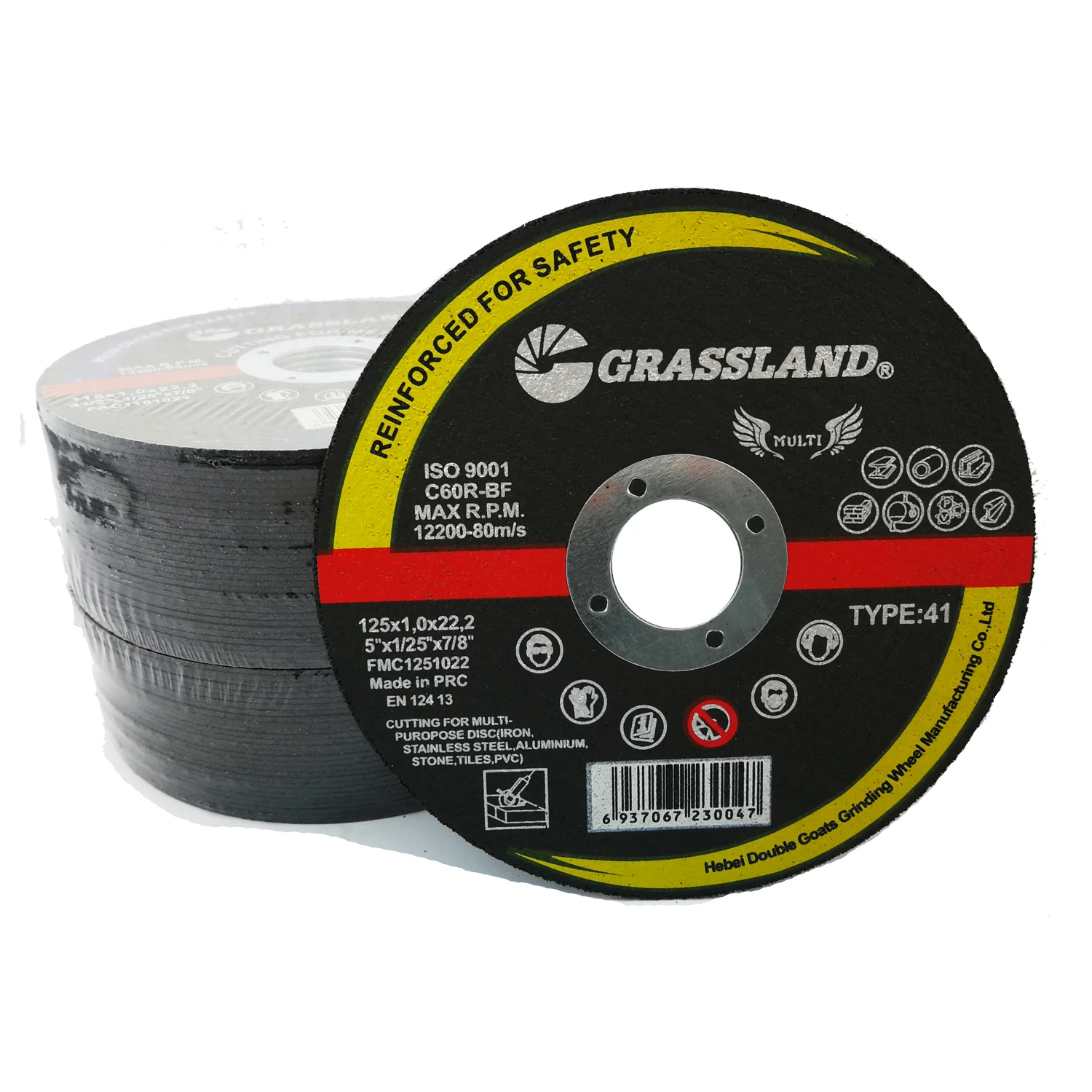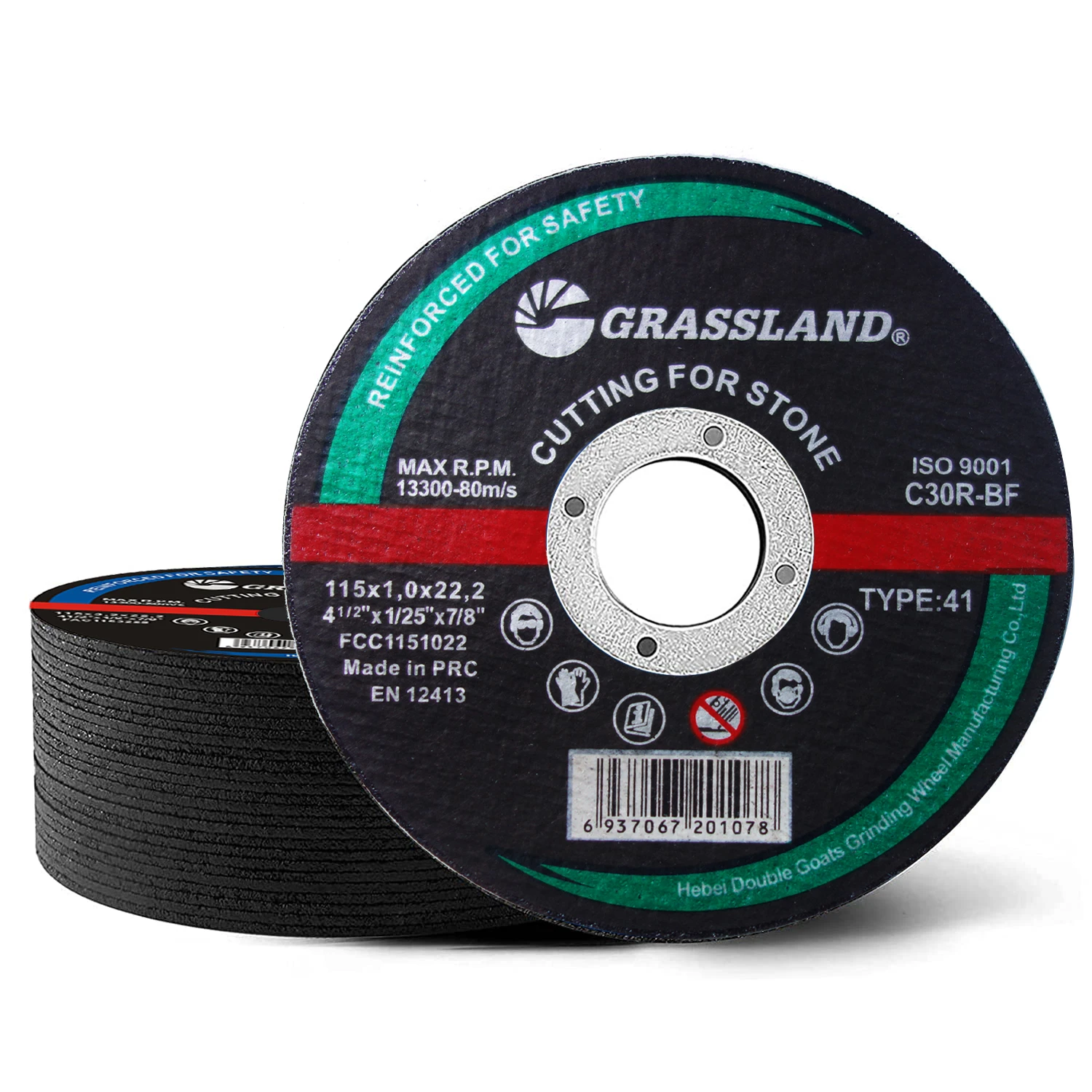The Critical Role of Stainless Steel Cutting Discs in Modern Industry
In the dynamic landscape of industrial fabrication and construction, precision and efficiency are paramount. The choice of abrasive tools significantly impacts project timelines, material integrity, and operational costs. Among these tools, stainless steel cutting discs stand out as indispensable for processing stainless steel and other high-alloy metals. These specialized discs are engineered to deliver clean, fast, and burr-free cuts, minimizing material waste and subsequent finishing work. Their unique composition and manufacturing processes address the specific challenges posed by stainless steel, such as its high heat sensitivity and work-hardening properties.
The global market for abrasives, including advanced cutting discs, is experiencing steady growth, driven by expansion in manufacturing, automotive, aerospace, and energy sectors. Projections indicate a compound annual growth rate (CAGR) of approximately 5-7% for the industrial abrasives market over the next five years, with specialized products like the stainless steel grinding disc and stainless cutting disc leading innovation. End-users increasingly demand discs that offer extended service life, enhanced safety, and superior cutting performance, even under demanding conditions. This demand fuels continuous research and development into novel abrasive materials and bonding technologies, ensuring that today’s cutting tools meet tomorrow’s industrial challenges.
The Meticulous Manufacturing Process of Stainless Steel Cutting Discs
The production of a high-performance cutting disc for stainless steel is a complex, multi-stage process that combines advanced material science with precision engineering. Each step is critical to ensure the disc's structural integrity, abrasive efficiency, and safety.
1. Raw Material Selection and Preparation
- Abrasive Grains: High-quality abrasive grains are the heart of any cutting disc. For stainless steel applications, common choices include high-purity fused aluminum oxide (Al2O3) or zirconium aluminum oxide (ZA). Zirconia is often preferred for its exceptional toughness and self-sharpening properties, which are crucial for cutting hard and heat-sensitive materials like stainless steel. Grain size is precisely controlled, typically ranging from 36 to 60 grit for optimal balance between cutting speed and finish.
- Resinoid Bond: Phenolic resins are predominantly used as the bonding agent due to their excellent heat resistance, strength, and ability to form a strong matrix around the abrasive grains. Specialized resins are developed to minimize thermal degradation during aggressive cutting.
- Reinforcement Layers: Multiple layers of high-tensile fiberglass mesh are incorporated to provide mechanical strength and safety, preventing the disc from shattering under high rotational speeds and lateral forces. The number and orientation of these layers are critical for disc integrity.
- Fillers and Additives: Cryogenic fillers (e.g., cryolite, potassium fluoroborate) are often added to reduce heat generation in the cutting zone, preventing workpiece discoloration and improving cutting efficiency. Iron, sulfur, and chlorine (Fe, S, Cl) content is strictly controlled to be below 0.1% for "Inox" designated discs to prevent contamination and corrosion of the stainless steel workpiece.
2. Mixing and Forming (Molding)
The abrasive grains, resin powders, and fillers are precisely weighed and thoroughly mixed in high-shear mixers to achieve a homogeneous blend. This mixture is then fed into automated presses, where it is combined with the fiberglass reinforcement layers and pressed under high pressure into the desired disc shape. The pressing process ensures uniform density and compaction, which are vital for disc balance and performance.
3. Curing (Baking)
After molding, the "green" discs are transferred to large industrial ovens for a controlled curing process. This involves heating the discs to specific temperatures (typically 180-200°C) for several hours. During curing, the phenolic resin undergoes polymerization, forming a rigid, thermoset bond that permanently fuses the abrasive grains and reinforcement layers. The precise temperature profiles and duration are crucial for achieving optimal bond strength and preventing internal stresses.
4. Finishing and Quality Control
Post-curing, the discs undergo several finishing steps:
- Center Hole Finishing: The center arbor hole is accurately machined to ensure precise fitment on angle grinders or cut-off saws.
- Balancing: Each disc is dynamically balanced to minimize vibration during operation, enhancing safety and cutting precision.
- Speed Testing: Discs are subjected to rigorous overspeed testing, spun at speeds significantly higher than their rated maximum operational speed to verify burst strength and integrity.
- Adherence to Standards: All manufactured stainless steel cutting wheels must comply with international safety standards such as EN 12413 for bonded abrasives, ISO 9001 for quality management systems, and ANSI B7.1 for abrasive wheel safety. These standards dictate maximum operating speeds, labelling requirements, and testing protocols.
Throughout this process, continuous monitoring and statistical process control (SPC) ensure batch consistency and adherence to strict quality parameters, resulting in a reliable and high-performance product with an extended service life, typically measured in terms of cuts per disc or overall material removal rate.
Technical Specifications: Grassland Inox Cutting Disc Overview
Understanding the technical specifications of a cutting disc is crucial for selecting the right tool for a given application. The Grassland 4.5 Inch 115 Mm X 1 Mm X 22.2 Mm Inox Cutting Disc is specifically designed for optimal performance on stainless steel. Its "Inox" designation confirms a strict adherence to chemical composition requirements, ensuring minimal contamination of the workpiece.

Grassland 4.5 Inch Inox Cutting Disc Parameters
The 1.0 mm thickness is particularly noteworthy for the stainless steel cutting wheel. This ultra-thin profile allows for minimal material loss, precise cuts, and reduced friction, which in turn leads to less heat buildup in the workpiece – a critical factor when working with stainless steel to prevent discoloration, warping, and altered material properties. The high maximum RPM of 13,300 ensures compatibility with professional-grade angle grinders, facilitating rapid material severance.
Versatile Application Scenarios Across Industries
The robust performance and specialized design of stainless steel cutting discs make them indispensable across a broad spectrum of industrial sectors, where high precision and material integrity are non-negotiable.
- Petrochemical Industry: For cutting stainless steel pipes, valves, and structural components in refineries and chemical plants, where corrosion resistance is paramount. Discs must not introduce contaminants that could compromise the material's integrity.
- Metallurgy and Fabrication: Essential for processing stainless steel sheets, profiles, and tubes in general metalworking shops, shipyards, and heavy machinery manufacturing. Fast, clean cuts reduce post-processing, saving time and resources.
- Water Supply & Drainage Infrastructure: Used for modifying and installing stainless steel conduits, pumps, and other components in water treatment facilities and pipeline networks, where hygiene and longevity are critical.
- Automotive Manufacturing: For precision cutting of stainless steel exhaust systems, chassis components, and decorative trims. Minimal heat transfer prevents material distortion.
- Construction and Renovation: Cutting rebar, stainless steel railings, frames, and other architectural elements. The ability to achieve quick and clean cuts in challenging environments enhances productivity.
- Food and Pharmaceutical Processing: Crucial for fabricating and modifying stainless steel equipment (tanks, pipelines, work surfaces) where hygiene standards are extremely high, and no iron contamination can be tolerated.
In these diverse applications, the advantages of a high-quality stainless steel cutting wheel are evident: energy saving through reduced cutting time, superior corrosion resistance due to absence of contaminants, and significantly prolonged service life of the cutting tool itself.
Technical Advantages and Operational Benefits
The distinct technical advantages of specialized stainless steel cutting discs translate directly into significant operational benefits for industrial users.
- Optimized Abrasive Formulation: The use of advanced abrasive grains (e.g., zirconia, ceramic aluminum oxide) and specialized bonding agents results in a disc that maintains its sharpness and cutting aggression longer when interacting with stainless steel's tough, work-hardening properties. This leads to consistent cutting performance and extended disc life.
- Minimal Heat Generation (Cool Cutting): The "Inox" designation implies a low Fe, S, Cl content, combined with integrated cooling fillers. This design minimizes heat transfer to the workpiece, effectively preventing material discoloration (blueing), warping, and structural changes. This "cool cutting" capability is vital for maintaining the aesthetic and metallurgical properties of stainless steel.
- Precision and Clean Cuts: The thin profile (e.g., 1.0 mm for Grassland discs) significantly reduces the kerf width, leading to minimal material loss. This precision results in cleaner cuts with fewer burrs, drastically reducing the need for secondary grinding or finishing operations, thereby saving labor and consumable costs.
- Enhanced Safety: Reinforced with multiple layers of high-tensile fiberglass, these discs offer superior burst resistance, meeting stringent safety standards like EN 12413. This enhanced structural integrity reduces the risk of accidents, contributing to a safer work environment.
- Corrosion Resistance Preservation: By being free of contaminants like iron, sulfur, and chlorine, these discs prevent the introduction of foreign elements that could initiate rust or compromise the inherent corrosion resistance of stainless steel. This is a critical advantage in applications where long-term material performance is essential.
- Increased Productivity: The combination of fast cutting speed, extended disc life, and reduced need for post-processing directly translates into higher operational efficiency and productivity. Fewer disc changes and less rework mean more completed tasks per shift.
These advantages position specialized cutting disc for stainless steel as a cost-effective solution, despite potentially higher initial unit costs compared to general-purpose abrasive wheels. The total cost of ownership is significantly lower due to improved efficiency, extended tool life, and superior workpiece quality.
Vendor Comparison and Selection Criteria
Choosing the right supplier for stainless steel grinding disc and cutting solutions is as critical as selecting the right product. B2B decision-makers must evaluate vendors based on a comprehensive set of criteria beyond just price.
Key Evaluation Factors:
- Product Performance & Consistency: Does the vendor consistently deliver discs that meet performance benchmarks for speed, life, and cut quality? Ask for test data and independent certifications.
- Certifications and Compliance: Ensure products meet international safety and quality standards (e.g., EN 12413, ISO 9001). This indicates a commitment to quality and safety.
- Technical Support & Expertise: A knowledgeable vendor can provide guidance on disc selection, optimal usage, and troubleshooting, which adds significant value.
- Customization Capabilities: For unique applications, the ability to customize disc specifications (size, abrasive, bond) is a major advantage.
- Supply Chain Reliability: Timely delivery and consistent stock availability are crucial to avoid production delays.
- Pricing and Total Cost of Ownership (TCO): While competitive pricing is important, evaluate the TCO, considering disc life, efficiency gains, and reduced post-processing, which often outweigh initial unit cost differences.

Generic Vendor Comparison Factors Table
Customized Solutions for Specific Needs
While standard stainless cutting disc offerings meet most general-purpose needs, many industrial applications present unique challenges that necessitate customized abrasive solutions. Reputable manufacturers recognize this and offer tailor-made discs to optimize performance for specific materials, equipment, and operational parameters.
Customization options can include:
- Specific Dimensions: Discs can be manufactured with non-standard diameters, thicknesses, or arbor hole sizes to fit specialized cutting machinery or reach confined spaces.
- Abrasive Grain Blends: Different blends of abrasive grains (e.g., specific ratios of zirconia to aluminum oxide, or incorporating ceramic grains) can be formulated to optimize cutting aggression and disc life for particular stainless steel alloys or even other challenging materials.
- Bond Hardness and Flexibility: The resinoid bond's hardness can be adjusted. A harder bond offers longer life in lighter applications, while a softer bond exposes new abrasive grains faster for aggressive cutting on harder materials.
- Cooling Additives: For highly sensitive applications where heat generation must be absolutely minimized, the type and concentration of cryogenic cooling fillers can be adjusted to provide maximum thermal dissipation.
- Reinforcement Modifications: The number and type of fiberglass layers can be tailored to increase burst strength for extremely high-speed applications or to improve flexibility for certain cutting angles.
Engaging with a manufacturer that offers robust R&D and engineering support for customized solutions ensures that businesses can achieve peak performance, even for the most demanding or niche cutting tasks, maximizing both efficiency and safety.
Application Case Studies: Real-World Performance
Demonstrating the tangible benefits of high-quality stainless steel cutting discs through real-world applications highlights their value to B2B clients.
Case Study 1: Large-Scale Pipeline Fabrication
A major petrochemical construction firm was tasked with fabricating several kilometers of stainless steel (316L) pipelines for a new chemical processing plant. Their existing cutting discs were leading to excessive disc wear, slow cutting speeds, and frequent instances of heat discoloration on the pipes, requiring costly post-grinding and polishing.
- Challenge: Improve cutting efficiency, extend disc life, and eliminate heat-induced discoloration on 316L stainless steel pipes (10-15mm wall thickness).
- Solution: The firm switched to Grassland 4.5 Inch 115 Mm X 1 Mm X 22.2 Mm Inox Cutting Discs. The ultra-thin profile and specialized abrasive/bond system were ideal for the heat-sensitive material.
-
Results:
- Cutting time per pipe reduced by an average of 15%.
- Disc life increased by 30-35%, significantly reducing consumable costs and downtime for disc changes.
- Heat discoloration was virtually eliminated, saving an estimated 20% in post-processing labor.
- Overall project timeline was accelerated by 7%.
Case Study 2: Automotive Exhaust System Manufacturing
An automotive parts manufacturer specializing in high-performance stainless steel (409L) exhaust systems needed a solution for precise cutting of thin-walled tubing and intricate bracketry without causing burrs that could impede airflow or require extensive deburring.
- Challenge: Achieve very clean, burr-free cuts on thin-gauge 409L stainless steel tubing and sheets, while maintaining fast production speeds.
- Solution: The manufacturer implemented a tailored solution using premium stainless steel cutting wheels with a specific grain blend and slightly softer bond for optimal self-sharpening on thinner materials, coupled with a 0.8mm thickness for ultra-fine cuts.
-
Results:
- Burr formation reduced by 90%, virtually eliminating the need for secondary deburring.
- Cutting accuracy improved by 20%, leading to better-fitting components.
- Scrap rate due to poor cuts decreased by 10%.
- Overall production throughput increased by 12% due to faster, cleaner initial cuts.
Ensuring Trustworthiness: Certifications, Support, and Guarantees
In the B2B sector, trust is built on verifiable expertise, reliable service, and transparent commitments. For critical consumables like stainless steel cutting discs, manufacturers must demonstrate unwavering dedication to quality and customer satisfaction.
Industry Certifications and Authoritative References:
- EN 12413: All high-quality cutting discs, including the Grassland Inox line, conform to the European standard EN 12413 for bonded abrasive products. This certification guarantees that the discs meet rigorous safety requirements for burst strength, imbalance, and marking.
- ISO 9001: Manufacturing facilities adhering to ISO 9001 quality management systems demonstrate a consistent commitment to quality control throughout the production process, from raw material sourcing to final product inspection.
- Fe, S, Cl This technical specification, verified through precise material analysis, ensures that the disc will not introduce contaminants that lead to pitting corrosion or embrittlement in stainless steel workpieces. It's a key indicator of suitability for stainless applications.
Warranty and After-Sales Support:
Manufacturers of premium cutting disc for stainless products typically offer a performance guarantee. This usually covers manufacturing defects and ensures the product meets advertised specifications. Comprehensive after-sales support includes:
- Dedicated technical support teams for application advice and troubleshooting.
- Prompt handling of warranty claims and product replacements.
- Access to safety data sheets (SDS) and technical documentation.
Lead Time and Fulfillment:
Efficient supply chain management is crucial for industrial clients. Reputable suppliers provide clear communication regarding lead times, which typically range from 3-5 business days for standard stock items to 2-4 weeks for specialized or bulk orders. Fulfillment processes are streamlined to ensure order accuracy and on-time delivery, supported by robust inventory management systems.
Frequently Asked Questions (FAQ)
Q: What makes an "Inox" cutting disc different from a standard cutting disc?
A: "Inox" specifically denotes that the disc is formulated with extremely low levels of iron (
Q: Can I use a stainless steel cutting disc on other materials?
A: Yes, Inox discs can typically be used on other ferrous metals, such as mild steel or cast iron. However, they are optimized for stainless steel, so using them on non-ferrous materials like aluminum is not recommended due to material loading and reduced efficiency. For mild steel, while they work, a dedicated mild steel disc might offer a better cost-per-cut ratio.
Q: How can I maximize the service life of my stainless steel cutting wheel?
A: To maximize life: use the correct RPM for your tool and disc, apply consistent and moderate pressure (avoid excessive force), ensure the disc is perpendicular to the workpiece for straight cuts, and store discs in a dry, temperate environment to prevent moisture absorption and bond degradation.
Q: Are thinner discs always better?
A: Thinner discs (e.g., 1.0mm) offer faster, cleaner cuts with less material loss and heat generation, which is ideal for stainless steel. However, they are more flexible and can be more prone to bending or premature wear if excessive side pressure is applied or if used for heavy-duty applications like grinding. For thicker materials or more aggressive cutting, a slightly thicker disc (e.g., 1.6mm or 2.5mm) might offer a better balance of life and stability.
Conclusion
The selection of appropriate stainless steel cutting discs is a pivotal decision for any operation working with stainless steel and high-alloy metals. As demonstrated, these specialized abrasive tools offer unparalleled precision, efficiency, and safety, specifically engineered to overcome the unique challenges of cutting stainless steel. By understanding their meticulous manufacturing process, technical specifications, and widespread application advantages, B2B decision-makers can make informed choices that optimize productivity, reduce operational costs, and uphold the integrity of their materials. Investing in high-quality, certified Inox cutting discs from reputable suppliers ensures not only superior performance but also adherence to critical industry standards and enhanced workplace safety. As industries continue to evolve, the demand for high-performance, specialized cutting solutions will only grow, underscoring the enduring importance of advanced abrasive technology.
References
- European Committee for Standardization. EN 12413:2007+A1:2011 Safety requirements for bonded abrasive products.
- International Organization for Standardization. ISO 9001:2015 Quality management systems — Requirements.
- American National Standards Institute. ANSI B7.1: Safety Requirements for the Use, Care, and Protection of Abrasive Wheels.
- ASM International. (2000). ASM Handbook Volume 16: Machining.
- Frost & Sullivan. (2023). Global Abrasives Market Outlook 2023.
Post time:Sep - 09 - 2025
















